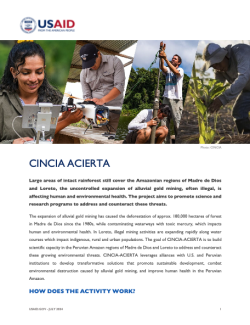The expansion of alluvial gold mining has caused the deforestation of approx. 180,000 hectares of forest in Madre de Dios since the 1980s, while contaminating waterways with toxic mercury, which impacts human and environmental health. In Loreto, illegal mining activities are expanding rapidly along water courses which impact indigenous, rural and urban populations.
The goal of CINCIA-ACIERTA is to build scientific capacity in the Peruvian Amazon regions of Madre de Dios and Loreto to address and counteract these growing environmental threats.
CINCIA-ACIERTA leverages alliances with U.S. and Peruvian institutions to develop transformative solutions that promote sustainable development, combat environmental destruction caused by alluvial gold mining, and improve human health in the Peruvian Amazon.
HOW DOES THE ACTIVITY WORK?
The Centro de Innovacion Cientifica Amazonica (CINCIA) fosters cutting-edge research to understand the impacts of gold mining in Madre de Dios and Loreto, strengthens the capacity of local research communities and the awareness of local stakeholders of mining threats. CINCIA introduces and pilots innovative and effective solutions like reforestation and restoration of mining areas using native plants and biochar, using AI to enhance drone and satellite imagery to better assess mining related degradation, and the use of aquatic drones to improve impact assessment of biodiversity in lakes and wetlands degraded by
gold mining.
CINCIA works with a diverse network of stakeholders dedicated to reducing the impacts of gold mining in the Amazon. This network includes key research institutions in the Peruvian Amazon, such as the National Amazonian University of Madre de Dios (UNAMAD), the National University of the Peruvian Amazon (UNAP), and the Research Institute of the Peruvian Amazon (IIAP), along with over 15 national and international public institutions and private sector partners, including formal mining concessionaires and organizations committed to responsible gold mining.

